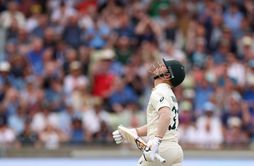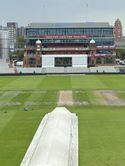Old Trafford, presently known as Emirates Old Trafford due to sponsorship reasons is a cricket ground located at Old Trafford, Greater Manchester, England. It was established in the year of 1857 and is the home ground to Manchester Cricket Club as well as Lancashire County Cricket Club.
It is one of the most renowned and second oldest test venue in England. On July 1884, the ground spotted the first ever Ashes Test held at England.
The stadium has a capacity to hold 26,000 spectators for international matches.
![]()
History
From the year 1857, the site was used as a cricket ground when Manchester Cricket Club moved in here. Initially, the Old Trafford’s ground was rocky and the games held at the ground only attracted a small crowd.
It was in the year 1884 that Old Trafford became the second English ground, only after The Oval, to stage Test cricket. The first test, played between England and Australia, ended in a draw.
During the Second World War, Old Trafford was used as a transit camp for troops returning from Dunkirk, and as a supply depot.
Major Matches
The ground is used heavily throughout the summer as the base of Lancashire County Cricket Club.
Until 2008, Old Trafford commonly hosted a Test match every year but no test match was hosted in years 2009, 2011 or 2012 due to substandard facilities of the ground. Following a redevelopment, it hosted the Ashes Test in 2013, and further Tests in 2014 and 2016.
One Day Internationals T20 internationals continue to be hosted every year.
Of all the test matches played at this very ground, the highest team score attained was 656/8 by the Australian national cricket team against England on 23rd of July, 1964.
In 1990, Sachin Tendulkar scored his first test hundred at the age of 17, and became the second youngest centurion at this very ground.
Another notable happening at the ground was in the year of 1993, when Shane Warne bowled the “Ball of the Century” to English batsman Mike Gatting on day two during the first Test of the 1993 Ashes series. Warne rolled his right arm over and delivered a leg break to the right-handed Gatting. In slow-motion, it can be seen that the ball initially travels straight down the pitch towards the batsman. As this ball travelled towards Gatting, the rapidly spinning cricket ball started to drift to the right but, it ended up pitching several inches outside Gatting's leg stump, taking his wicket and hence receiving the name.
Controversies
During the war, in December 1940, the ground was hit by bombs, damaging and destroying several stands. Despite this damage and the failure of an appeal to raise funds for repairs, cricket resumed promptly after the war as German PoWs paid a small wage to prepare the ground.
There was a gate money drop and lack of investment for the ground due to the differences of opinion between the club's committee and players led to a bad run of form in the 1950s and early 1960s. However, this situation was reversed after 1964.
Recent Matches
The recent and last Twenty20 international held at this very ground was on 7th of September 2016 between England and Pakistan.
The last test match held at the ground was between England and South Africa from 4th to 8th of August 2017.









